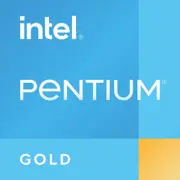Intel Pentium Gold 5405U

Intel Pentium Gold 5405U: A Budget Processor for Everyday Tasks in 2025
Introduction
The Intel Pentium Gold 5405U processor, released in 2019, remains a popular choice for budget laptops. Despite its age, it continues to be used in entry-level ultrabooks and devices for basic tasks. In this article, we will analyze its architecture, performance, use cases, and relevance in 2025.
Architecture and Process Technology
Whiskey Lake Features
The Pentium Gold 5405U belongs to the Whiskey Lake family, built on a 14-nm process technology. It is one of the last generations of Intel before the transition to 10-nm standards, optimized for energy efficiency.
- Cores and Threads: 2 cores, 4 threads thanks to Hyper-Threading.
- Frequencies: Base frequency is 2.3 GHz. There is no Turbo mode, which limits peak performance.
- Cache: L3 — 2 MB (less than Core i3/i5).
- Integrated Graphics: Intel UHD Graphics 610 with a base frequency of 300 MHz and a maximum of 950 MHz. It supports 4K output via HDMI 1.4 but is not suitable for intensive workloads.
Architecture Evolution
Whiskey Lake brought improvements in power management and support for Wi-Fi 6 (in some models), but these features are limited in the Pentium Gold 5405U. Compared to previous generations (Kaby Lake-R), the changes are minimal, with a slight enhancement in energy efficiency and stability.
Power Consumption and TDP
With a TDP of 15 W, the processor is ideal for thin laptops with passive or compact active cooling. In real-world scenarios, power consumption varies:
- Idle: 2-3 W.
- Office Tasks: 5-10 W.
- Peak Load: up to 15 W.
Energy-saving technologies include:
- Speed Shift: Dynamic frequency adjustment for quick transitions between states.
- C-States: Power consumption management during idle states.
Performance in Real-World Tasks
Office Work and Multimedia
- Documents, Browsing: Easily handles 10-15 tabs in Chrome, as well as office applications (Word, Excel).
- Videos: Streams 4K content (YouTube, Netflix) without lag, thanks to VP9 and H.265 decoding.
- Editing: Only suitable for basic editing in Shotcut or Filmora (rendering will take 2-3 times longer than on a Core i5).
Gaming
The Intel UHD 610 is a weak point. Examples of gaming performance (at low settings, 720p):
- CS:GO: 25–30 FPS.
- Minecraft: 30–40 FPS (without shaders).
- Stardew Valley, Terraria: 60 FPS.
For modern titles (Cyberpunk 2077, Fortnite), this processor is unsuitable.
Turbo Mode
The lack of Turbo Boost is a key downside. Under load, the frequency does not increase, limiting performance during short bursts of tasks (such as opening heavy files).
Use Cases
The Pentium Gold 5405U is suitable for:
1. Students — for note-taking, online courses, and Zoom conferences.
2. Office Workers — handling documents, email, and CRM systems.
3. Casual Users — social media and video watching.
Not Suitable For:
- Gamers.
- Designers, programmers, video engineers.
Battery Life
Laptops with this processor provide 6-10 hours of operation with a battery capacity of 40-50 Wh. For example:
- Video Playback: Up to 8 hours.
- Office Work: 6-7 hours.
Energy savings are provided by:
- Adaptive screen brightness.
- "Power Saving" mode in Windows.
- Disabling background processes.
Comparison with Competitors
AMD Athlon Silver 3050U
- Pros: 2 cores/2 threads, Vega 2 graphics.
- Cons: No Hyper-Threading, poorer multitasking capabilities.
- Conclusion: Pentium Gold wins due to 4 threads.
Apple M1 (in base MacBook Air)
- Pros of Apple: 3-4 times higher performance, 18 hours of battery life.
- Cons: Starting price of $999.
- Conclusion: Pentium Gold is relevant only with a budget of up to $500.
Intel Core i3-1115G4 (Tiger Lake)
- Pros: 2 cores/4 threads, frequency up to 4.1 GHz, Iris Xe graphics.
- Cons: Laptops cost more ($600+).
- Conclusion: For those who need extra power.
Pros and Cons
Strengths:
- Low price of laptops ($300–500).
- Energy efficiency.
- Sufficient for basic tasks.
Weaknesses:
- No Turbo Boost.
- Weak iGPU.
- Outdated 14-nm process technology.
Laptop Selection Recommendations
1. Type of Device: Ultrabooks (Acer Aspire 5, Lenovo IdeaPad 3).
2. RAM: Minimum of 8 GB DDR4.
3. Storage: SSD required (256 GB and above).
4. Display: Full HD for comfortable work.
5. Additional: Check ports (USB-C, HDMI), weight (up to 1.5 kg).
Avoid:
- Laptops with HDD and 4 GB of RAM.
- Devices without warranty.
Final Conclusion
The Intel Pentium Gold 5405U in 2025 is a choice for those who need an affordable laptop for study, document work, and browsing. Its advantages include low price, long battery life, and adequate performance for everyday tasks. However, for gaming, editing, or professional applications, it is advisable to consider models with Core i3/i5 or AMD Ryzen 3/5.
Suitable for:
- Students.
- Office workers.
- Users who value portability and budget.
If your needs do not exceed basic tasks, the Pentium Gold 5405U will be a reliable companion without overspending.
Basic
CPU Specifications
Memory Specifications
GPU Specifications
Miscellaneous
Benchmarks
Compared to Other CPU
Share in social media
Or Link To Us
<a href="https://cputronic.com/en/cpu/intel-pentium-gold-5405u" target="_blank">Intel Pentium Gold 5405U</a>